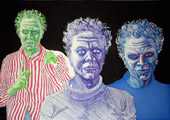|
(an
extract from)
The
Charm of Printmaking
Unlike
in regular drawing, in etching it is hard to see
what one is doing while drawing. One makes faintly
visible scratches on the copper plate with one's
nose against it, or depending on the technique in
some other way that forces one to be physically
close to the image and struggle with it, without
knowing what the result will look like, or even
what the line one is currently drawing will look
like. Paradoxically enough, exactly because of
this ignorance the maker can absorb him/herself in
the work. Therefore s/he is freer when engraving
the plate than a draughtsman is at his/her paper
or a painter at his/her canvas. Only the proofs
will show the printmaker what s/he has done. Only
they show the image s/he has drawn in its actual
colours and right way around. Thanks to the
distance the technique of printmaking allows its
maker, the proofs are a shock to the maker. When
one makes prints, one is at time same time
gloriously within it and utterly out of it at the
same time.
My favourite aspect of printmaking is the line. I
am currently trying to make a series that can hold
a candle to Francis
Goya’s series of 84 parts Los
Caprichos (1799). I have been staring at
the paintings and prints of Otto
Dix, Ernst
Ludwig Kirchner, Erich
Heckel (1883–1970), Adolf Wölfli, Antonin
Artaud (1896–1948) and Max
Beckmann – as well as those by countless
equally good but the less-well known artists, such
as Franz
Radziwill (1895–1983), Karl
Hubbuch (1891–1979), Franz Lenk (1898–1968), Christian
Schad (1894–1982) and Georg
Scholz (1890–1945) since I was a
teenager. There is a certain unintentional German
emphasis in this, which is hard for me to explain.
More important than their nationality for me is
that these idols and inspirations of mine were all
primarily line drawers. Their lines are angular,
toilsome, taut, convulsive or cramping, like a
slash of a knife. Printmaking, especially woodcuts
and metal engraving, are suitable for this use of
the line, because the plate offers resistance to
the drawer: it is harder to make a groove on a
copper plate than it is to draw a line on paper
with a brush or a pen.
One can attempt to scratch the subject precisely
and meticulously onto a plate in spite of the
stylus not obeying one’s hand, the needle slipping
on the slippery copper and the wooden plate
splitting unexpectedly. The image bears lines that
slip here and there and outlines that have been
drawn again and again, none of them the right one
but they all form a stuttering human choir
together, insecure, vague and therefore so very
true. This appeals to people whose concept of the
normal state of existence and its ideal form
emphasises tensions and irreconciled conflicts. If
the line is meant to embody the pressure of
existence, violent conflicts, the inescapable and
wound-like separateness of the subject and being
human primarily as experiencing pain and friction,
then the resistance of a polished metal plate or
crooked wooden plate is a great joy to the
draughtsman.
There are other ways of reacting to the difficulty
of making a line, like pruning off unnecessary
lines for example, by refining the expression so
that it consists of few but thought-provoking
strokes. The figures in Emil
Hansen Nolde’s (1867–1956) and Edward
Munch’s (1863–1944) woodcuts have been
condensed into simple but powerful characters.
On the other hand, drawing a line does not have to
be difficult in printmaking. It can be even more
fluent than drawing the same line on drawing paper
or canvas. It was a great revelation to me when I
understood that some techniques of etching and
engraving allow the stylus or brush to glide more
agilely than a canvas or drawing paper does.
For line etching a copper plate is first varnished
for drawing on it. If wanted, the varnished
surface can be made even more sensitive to the
artist’s touch than paper is to the drawer’s touch
or canvas to the painter’s. In hard-ground etching
one can draw lines on the copper plate. The lines
are more precise and agile than what one can draw
on paper with the finest of nibs. In soft-ground
etching a thin paper is stretched on the varnished
copper plate, and one draws on the paper with a
pencil. The soft layer of varnish underneath the
paper registers the drawer’s touch even more
sensitively than drawing paper – the soft-ground
is like oversensitive paper that makes even those
lines visible which could not be perceivable if
they were drawn on paper.
The Charm of Printmaking is a
chapter in the essay Toolbox,
included in the written part of my
doctoral thesis:
Darkness Visible – Essays on Art, Philosophy and
Politics
(2005, English version 2007).
|























